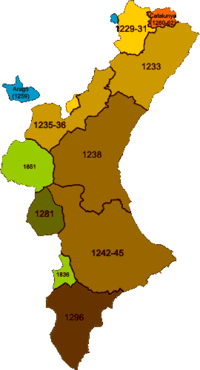Siege of Burriana
| Siege of Burriana | |||||||
|---|---|---|---|---|---|---|---|
| Part of the Reconquista (Aragonese conquest of Valencia) | |||||||
 Chronological map documenting the Conquest of Valencia. | |||||||
| |||||||
| Belligerents | |||||||
 Crown of Aragon Crown of Aragon Knights Hospitaller Knights Hospitaller Knights Templar Knights Templar Senyoria d'Albarrasí Senyoria d'Albarrasí | Taifa of Valencia | ||||||
| Commanders and leaders | |||||||
 James I of Aragon James I of Aragon Bernat Guillem de Montpellier Bernat Guillem de Montpellier Bernat Guillem d'Entença Bernat Guillem d'Entença | Zayyan ibn Mardanish | ||||||
- v
- t
- e
- 8th century
- Covadonga
- 1st Roncevaux Pass
- Burbia River
- Orbieu River
- Lutos
- Las Babias
- Río Quirós
- Río Nalón
- Oviedo
- 9th century
- 1st Barcelona
- 1st Tortosa
- Pancorbo
- 2nd Roncevaux Pass
- Clavijo
- Albelda
- Guadalacete
- Monte Laturce
- Morcuera
- Polvoraria
- 1st Cellorigo
- 2nd Cellorigo
- 2nd Barcelona
- 10th century
- Day of Zamora
- Pallars and Ribagorza
- 1st San Esteban de Gormaz
- 2nd San Esteban de Gormaz
- Valdejunquera
- 1st Toledo
- Alhandic
- Simancas
- Estercuel
- Torrevicente
- Rueda
- 3rd Barcelona
- 11th century
- Cervera
- Calatañazor
- Torà
- Albesa
- Aqbat al-Bakr
- Graus
- Coimbra
- Barbastro
- Paterna
- Llantada
- Golpejera
- Cabra
- Piedra Pisada
- Morella
- 2nd Toledo
- 1st Zaragoza
- Sagrajas
- Tudela
- Tévar
- 3rd Toledo
- 1st Valencia
- Alcoraz
- Bairén
- Consuegra
- 4th Toledo
- 5th Toledo
- 12th century
- 2nd Valencia
- Mollerussa
- Uclés
- Norwegian raid
- 6th Toledo
- Talavera
- 1st Balearic Islands
- Candespina
- 1st Santarém
- 2nd Balearic Islands
- Martorell
- Coimbra
- 2nd Zaragoza
- Cutanda
- 1st Granada
- 3rd Valencia
- 1st Badajoz
- Fraga
- 1st Coria
- Ourique
- Oreja
- 2nd Coria
- 1st Lisbon
- 1st Montiel
- Almería
- Al-Ludjdj
- 2nd Santarém
- Sacavém
- 2nd Lisbon
- 2nd Tortosa
- 2nd Badajoz
- 3rd Santarém
- Alvor
- 1st Silves
- 2nd Silves
- Tomar
- Alarcos
- 13th century
- Al-Dāmūs
- Las Navas de Tolosa
- Alcácer do Sal
- 1st Jaén
- Peníscola
- Aragonese raid
- Majorca
- 2nd Jaén
- 1st Jerez
- Ares
- Burriana
- Córdoba
- El Puig
- 4th Valencia
- Algarve
- 1st Xàtiva
- 2nd Xàtiva
- Biar
- 3rd Jaén
- 2nd Seville
- Faro
- 2nd Jerez
- Mudéjar revolt
- 3rd Jerez
- 1st Murcia
- Écija
- Martos
- Montesa
- 1st Algeciras
- 2nd Algeciras
- Moclín
- Iznalloz
- 14th century
- 1st Gibraltar
- 3rd Algeciras
- Almería
- 2nd Gibraltar
- Vega de Granada
- Shepherds' Crusade
- Teba
- 3rd Gibraltar
- 4th Gibraltar
- Vega de Pagana
- Getares
- Río Salado
- Estepona
- 4th Algeciras
- 5th Gibraltar
- Linuesa
- Guadix
- 2nd Montiel
- 5th Algeciras
- 2nd Murcia
- 15th century
- Collejares
- Antequera
- 6th Gibraltar
- La Higueruela
- 7th Gibraltar
- Los Alporchones
- 8th Gibraltar
- 9th Gibraltar
- 2nd Granada campaign
- Lucena
- Málaga
- Post-Reconquista Rebellions
- 1st Alpujarras
- 2nd Alpujarras
- North Africa
The siege of Burriana was one of the battles that occurred during the Conquest of Valencia by James I of Aragon. Burriana was an important Muslim city, being the capital of La Plana, Valencia. It was known as the "Green City". The city was besieged for two months, finally falling to the forces of James I in July 1233.
Context
In 1229, the city of Valencia, known to the Muslims as "Balansiya", had fallen to the forces under the command of Zayyan ibn Mardanish, a local leader who was opposed to the Almohades. In capturing that city, he dethroned Zayd Abu Zayd, who subsequently fled to the Kingdom of Aragon. James I of Aragon used this as a casus belli to intervene in the Muslim civil war on the side of the Almohades, but in reality with the pretext of expanding his own territory.
Two Aragonese knights, Hugo de Follalquer, Grand Master of the Knights Hospitaller, and Blas de Aragón, who had just returned from a period of exile in Valencia, met with Jaime I at Alcañiz. They recounted stories of the prosperity of the Muslim kingdom and encouraged the king to conquer it in 1233.
Consequences
After taking Burriana, the castles to the north continued to fall into Aragonese hands one by one including; Peniscola, Castelló de la Plana, Borriol, les Coves de Vinromà and Vilafamés. Three years later, the decisive Battle of the Puig sealed the conquest in 1236.
See also
References
- The information on this page was translated from its Spanish equivalent.
Bibliography
Zurita y Castro, Jerónimo (2003). "Book III" (PDF). Anales de Aragón (Edició d'Ángel Canellas López. Edició electrònica de José Javier Iso, María Isabel Yagüe i Pilar Rivero ed.). Institución Fernando el Católico. p. 238.
Linajes de Aragón (PDF) (in Spanish). Los Cornel. Archived from the original (PDF) on 2011-03-04.
39°53′22″N 0°05′03″W / 39.88944°N 0.08417°W / 39.88944; -0.08417














